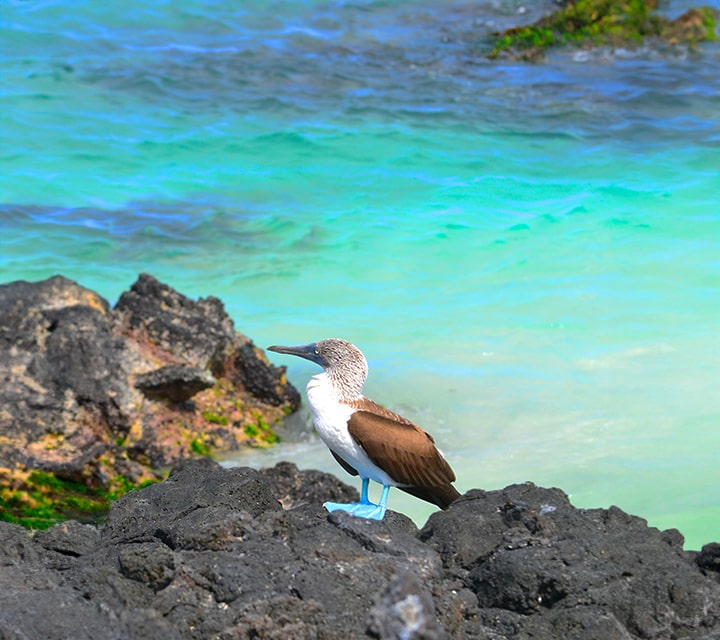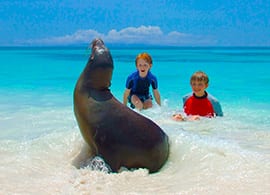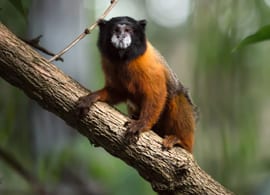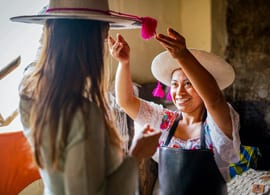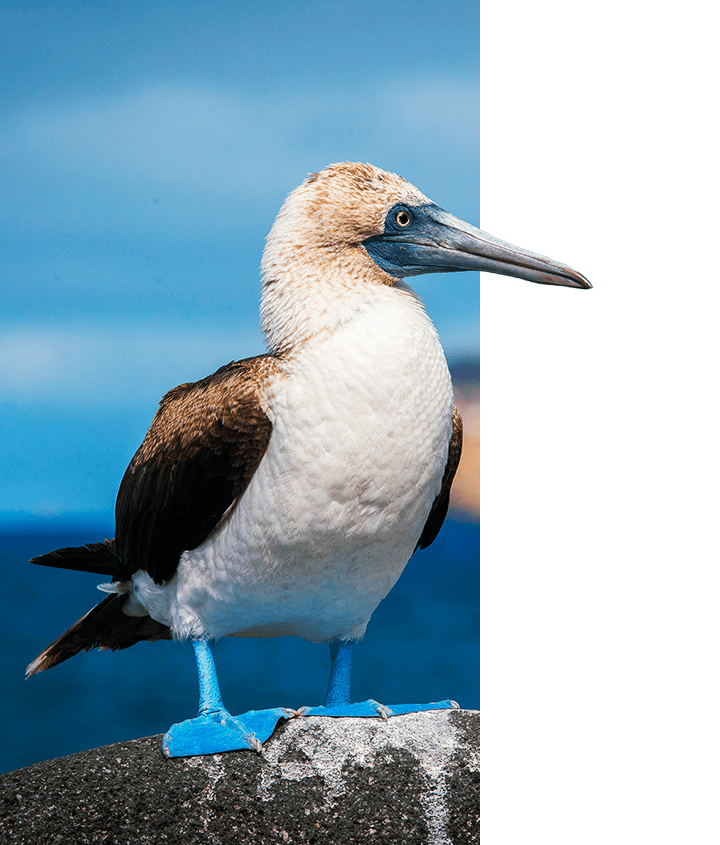
Ever heard of a bird with such an oddball name and vibrant turquoise feet? I'm talking about the Galapagos blue-footed booby. Why such a peculiar name, you ask? And what's up with those brilliant blue feet?
You see, these birds have a certain flair to them. Not just because they sport some fancy footwork during their mating dance, but also due to the unique pigment that gives their webbed feet that striking hue.
Intrigued yet? Hold on tight as we unravel this mystery together. We'll dive into understanding why they're named so comically and how their diet impacts the intensity of their foot coloration. But it doesn't stop there; get ready to learn about their fascinating behaviors influenced by population dynamics and discover insights into breeding problems causing conservation concerns.
JUMP TO SECTIONS:
- Unraveling the Mystery of Galapagos Blue-Footed Boobies
- The Vibrant Physical Traits of Blue-Footed Boobies
- Decoding Behavior and Mating Rituals of Blue-Footed Boobies
- Nesting Habits and Reproduction Cycle of Blue-Footed Boobies
- The Dietary Preferences and Feeding Habits of Blue-Footed Boobies
- Understanding the Conservation Status and Threats to Blue-Footed Boobies
- The Intriguing Facts and Adaptations of Blue-Footed Boobies
- Exploring the Habitat of Blue Footed-Boobies in the Galapagos Islands
- FAQs in Relation to Strange Name & Colorful Feet: Galapagos Blue-Footed Boobies
- Conclusion
Unraveling the Mystery of Galapagos Blue-Footed Booby
If you've ever wondered why these intriguing birds have such a peculiar name and vividly colored feet, then buckle up. We're about to dive into the captivating world of Galapagos blue-footed boobies.
Belonging to the family Sulidae and scientifically known as Sula nebouxii, these seabirds are quite fascinating. They flaunt an impressive wingspan that stretches nearly 5 ft., tipping the scales at around 1.5 kgs (3.25 lbs).
The blue-footed booby's moniker might sound amusing, but it stems from their clumsy movement on land—they're more agile in water or air. The Spanish word 'bobo', meaning stupid, is where this strange name originates.
The most striking feature? Their turquoise-blue feet. And here's a fun fact: males with brighter blue feet attract more females during mating season.
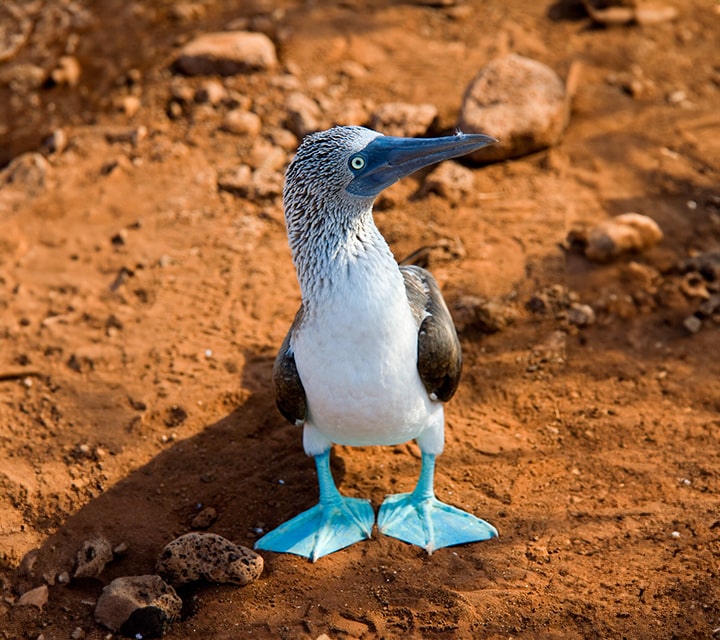
Breeding Rituals That Will Make You Chuckle.
Mating rituals among blue footed boobies are pretty interesting; involving a dance display that showcases those bright webbed wonders like no other bird can. It's nature’s way of saying “Look at me!” A male booby lifts his brightly colored foot high off the ground in what looks like some serious toe-tapping action.
A Little More About Those Vivid Feet...
Ever wonder how their feet get so blue? Well, it all comes down to diet – carotenoid pigments found in fresh fish give them that vibrant hue. Not only do these birds have stunning coloration but also some unique physical traits. Long pointed wings and white patches make them a sight to behold in the Galapagos Islands.
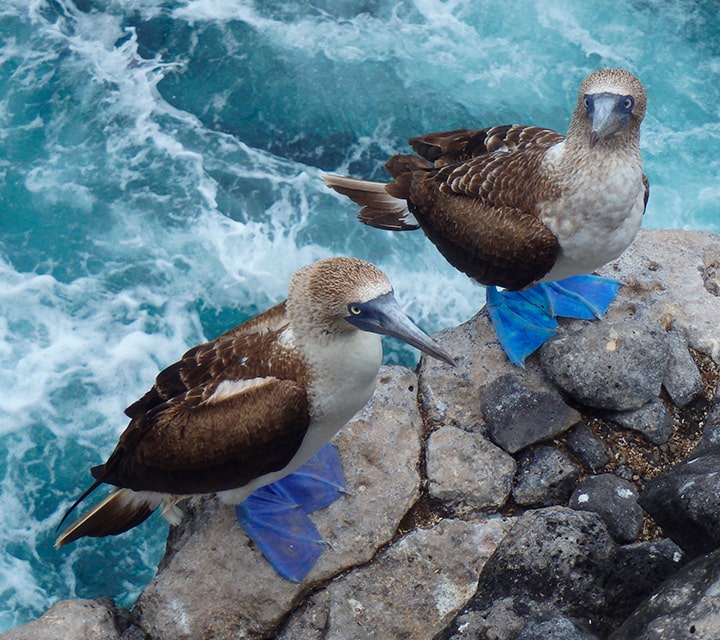
Despite their charm and quirky dance moves, blue-footed boobies face breeding problems due to mortality rates and changing environmental conditions. Conservation efforts are underway to ensure that we can continue marveling at these endemic species for generations.
Seeing blue-footed boobies can be a truly enriching experience. These birds boast an eye-catching appearance and possess distinctive behavior that makes them stand out from other types of animals. Delving into their world opens up fascinating insights into the wonders of nature and biodiversity.
Key Takeaway
Ever puzzled over the peculiar name and vibrant feet of Galapagos blue-footed booby? These intriguing birds, part of the Sulidae family, boast a wingspan almost 5 ft. wide and weigh about 3.25 lbs. The amusing name 'booby' stems from their awkward land movement—they're agile in water or air.
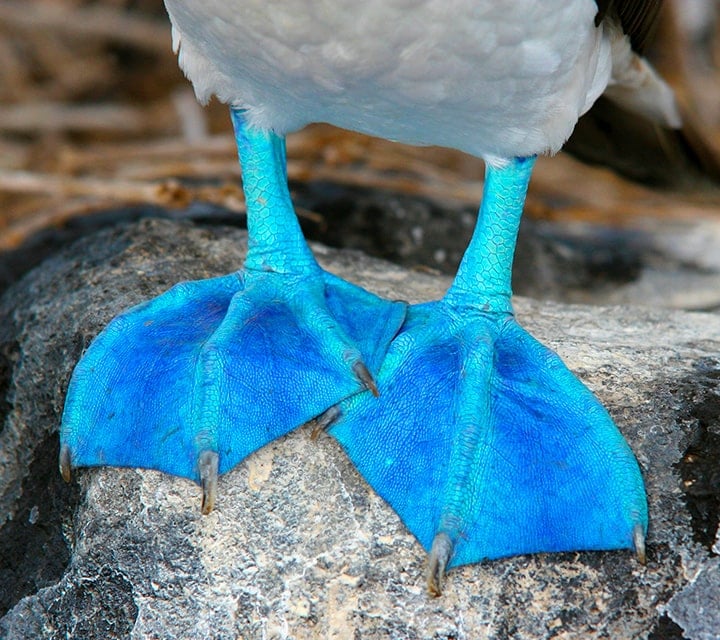
The Vibrant Physical Traits of Blue-Footed Boobies
Let's talk about the blue-footed boobies, those eye-catching birds with a peculiar name and even more intriguing looks. The striking feature that grabs everyone's attention is, without a doubt, their bright blue feet.
The Role of Carotenoid Pigments in Their Vivid Foot Coloration
These large webbed feet are not just for show. They play an essential role during mating rituals when males use them to impress potential mates with some pretty fancy footwork. But what gives these feet their distinctive turquoise color?
Diet plays a big part here. It turns out that carotenoid pigments found in their food are responsible for this vibrant hue. These pigments cannot be produced by animals but must be ingested through diet—specifically from fresh fish like sardines and anchovies.
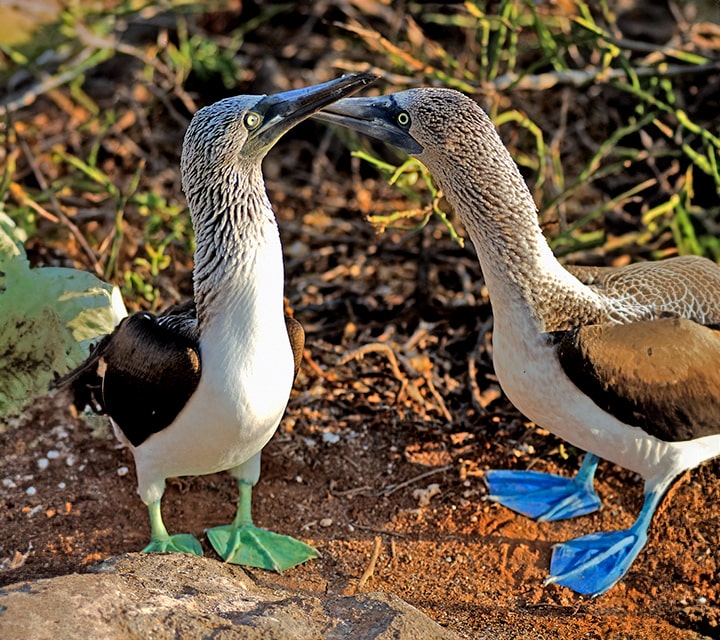
The Islands are home to 47 different species of Galapagos seabirds, the most remarkable being the blue-footed booby. Yet none stand out quite like our friend the blue-footed booby.
Apart from its stunning blue feet, another defining characteristic is its long pointed wings used primarily for diving into water to catch prey. Speaking of which—watch out if you're swimming below because they can dive from as high as 80 feet.
In contrast to its lower body parts' deep-blue palette, each bird has a white patch on the front side adding another interesting aspect to its overall appearance.
Decoding Behavior and Mating Rituals of Blue-Footed Boobies
If you've ever had the chance to witness blue-footed boobies in their native environment, one thing that's not hard to notice is their special courting dance. The males strut around with exaggerated steps, showing off their bright turquoise feet while lifting them high in an almost comedic display.
This spectacle isn't just for laughs though. It plays a vital role in attracting potential mates. Female boobies are known to prefer males with brighter blue feet, which signal good health and superior genes.
The Impact of Population Dynamics on Their Behaviors
Intriguingly, population changes also play a big part in shaping these behaviors. For instance, during times when food resources are scarce or booby populations are large, competition intensifies amongst males leading to more vigorous dances.
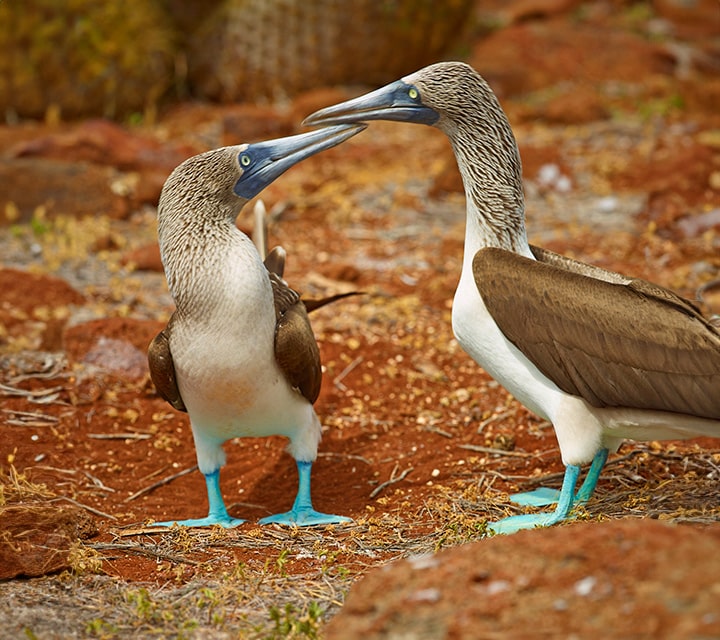
Another fascinating aspect is how they care for their young ones. Unlike many bird species where both parents share the duty of keeping eggs warm until hatching time comes around, blue-footed boobies often lay two eggs, but only rear one chick successfully due its strategy called “obligate siblicide”—a survival tactic employed by certain birds wherein stronger chicks outcompete weaker siblings for parental attention and resources.
Booby facts tell us that this behavior may seem cruel, but it ensures at least one offspring survives if conditions turn tough suddenly.
The Blue-Footed Booby Dance: A Show Stopper.
The most enchanting performance put up by these birds has got to be the male booby mating dance, with tail raised skyward he stomps his feet dramatically like some sort of avian flamenco dancer.
Interestingly, the brighter a male booby's feet are, the more attractive he is to females. The brilliance of their blue footedness can also be seen as an indicator of good health and fertility. So gents, if you're looking for love in the bird world, it's all about those fancy footwork.
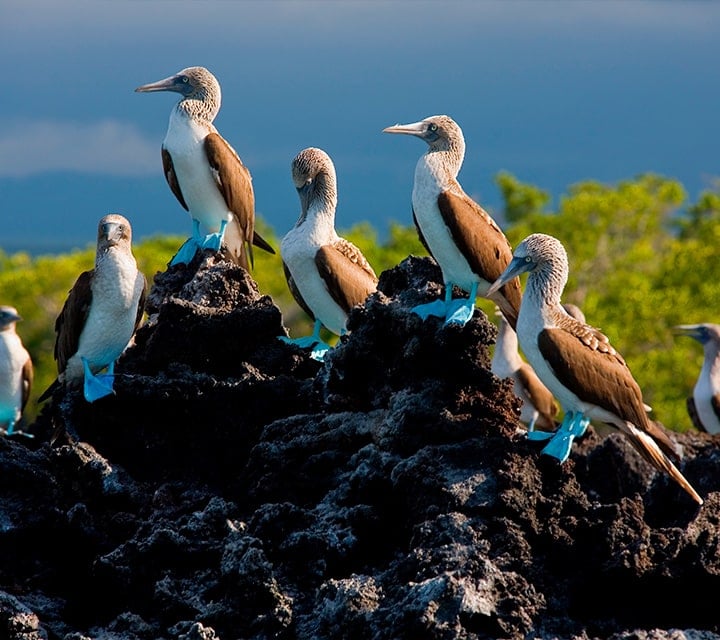
Key Takeaway
Watching blue-footed boobies dance is a unique spectacle. Males show off their bright feet to attract mates, with females preferring the bluest of them all —signaling good health and strong genes. Their behaviors are shaped by population dynamics too; scarce food or high populations can intensify competition among males. Interestingly, they usually rear only one chick successfully because this strategy enhances the offspring's chances for survival.
Nesting Habits and Reproduction Cycle of Blue-Footed Boobies
One striking aspect of blue-footed boobies’ behavior is their unique approach to nesting. Unlike many bird species, they don't build elaborate nests in trees or cliffs. Instead, these birds choose a patch of bare ground on the Galapagos Islands as their nursery.
The female booby lays 1-3 eggs, with each egg having its time under the sun before hatching. Breeding pairs take turns keeping the eggs warm—an impressive example of teamwork. It's interesting how both parents are involved in this process; from mating rituals that include dance moves and showing off bright blue feet to sharing parenting duties.
The breeding problems faced by these creatures can lead to high mortality rates among chicks, which makes conservation efforts even more critical for their survival. Discover more about these difficulties here.
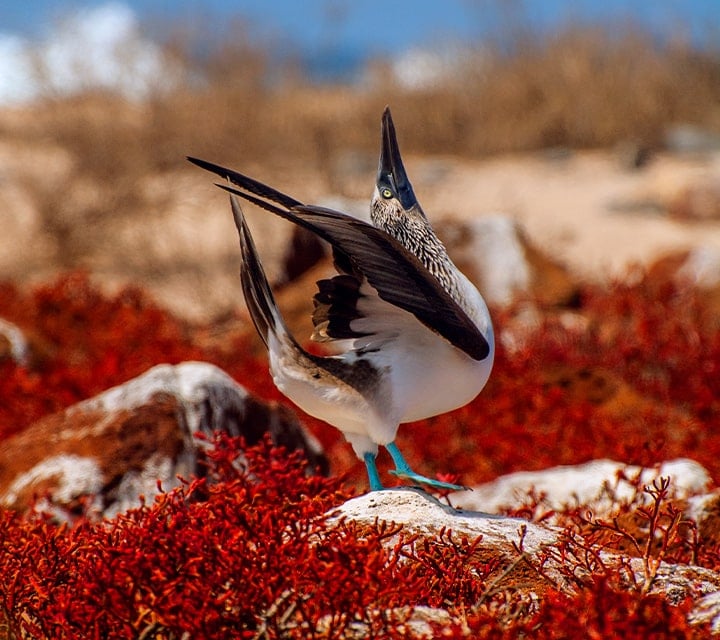
The Role of Carotenoid Pigments in Their Vivid Feet Coloration
Diet plays a crucial role in determining the color intensity of their large webbed feet. The carotenoid pigments found in fish contribute significantly towards maintaining those turquoise feet we so adore.
A male booby with brighter colored feet indicates good health and fertility, making him quite attractive during courtship dances. This article explains why diet matters when it comes to foot coloration.
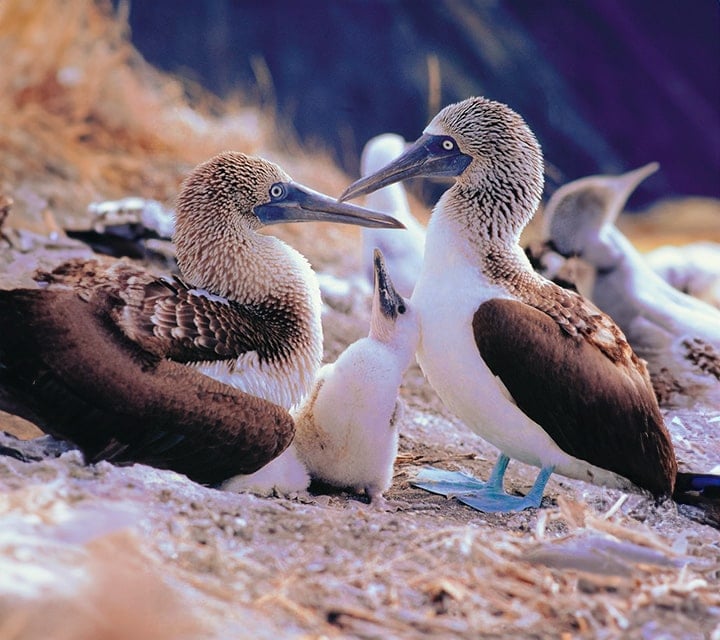
The Dietary Preferences and Feeding Habits of Blue-Footed Boobies
It's a bird-eat-fish world out there, especially for the Galapagos blue-footed boobies. They feed primarily on flying fish and squid which they spot from great heights.
Fascinatingly, their feeding behavior is more than just diving in to get a quick snack. It involves high-speed aerial acrobatics as well.
The footed booby plunge dives into the water at speeds up to 60 mph. To protect themselves during these intense dives, they have air sacs under their skin that cushion the impact with water.
Catching Prey Mid-Flight
Swooping down on unsuspecting prey mid-flight might seem like an impossible task but not for our avian friends here. These birds can snag flying fish right out of the air—a remarkable view if you're fortunate enough to behold it.
This airborne hunting method comes handy because flying fish often leap above water surface when threatened by underwater predators. This makes them easy pickings for sharp-eyed boobies soaring overhead.
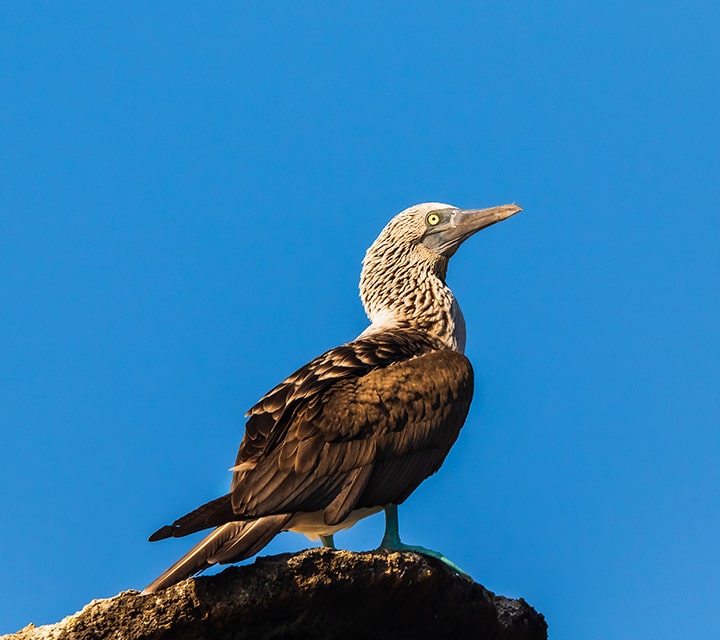
Diet Impact on Mating Success
You'd think being good hunters would be reward enough, but nope! Nature has another surprise in store. Turns out what they eat directly impacts their mating success too. Why do boobies have blue feet?
A diet rich in carotenoid pigments gives males those stunning turquoise feet that are so attractive to potential mates —talk about dinner influencing your dance moves!
Research shows that boobies with brighter feet—indicative of a better diet and health—perform more mating displays. The quality of their diet also impacts the number of eggs they lay.
All in all, these seabirds are truly fascinating creatures - every dive for food is an adventure and every meal potentially increases their chances at love.
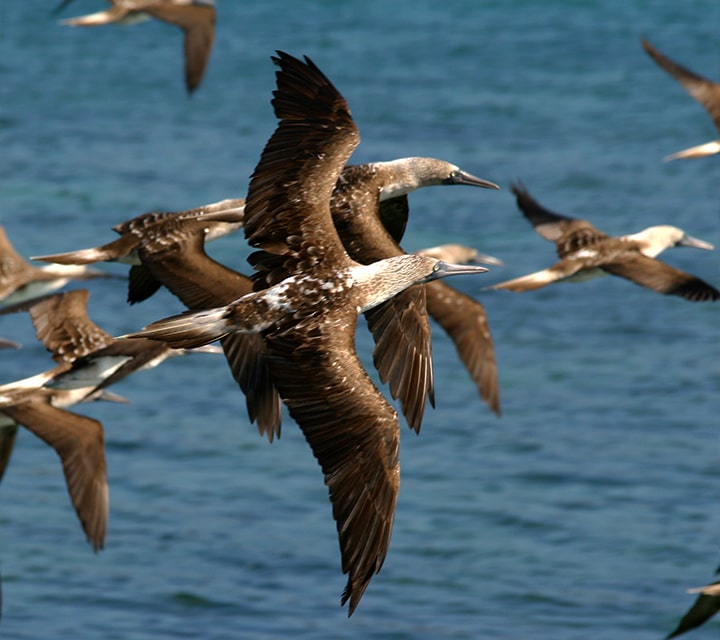
Key Takeaway
The blue-footed boobies of the Galapagos lead an exhilarating life, hunting flying fish and squid at remarkable speeds. But it's not just about survival—their diet has a significant impact on their romantic pursuits too. A nutrient-rich intake enhances the vibrancy of the males' feet, making them more appealing to potential mates and boosting their chances in breeding.
Understanding the Conservation Status and Threats to Blue-Footed Boobies
The Galapagos blue-footed booby, a charming bird known for its vibrant feet and mesmerizing dance moves, is currently under threat. The conservation efforts in place aim to help these unique creatures maintain their populations amidst several challenges.
A Dive into Conservation Efforts
Organizations like the Galapagos Conservancy are making strides to protect these quirky birds. They focus on habitat preservation and tracking of booby populations, key aspects that can ensure their survival. But despite such work, threats persist.
Pollution from plastics is one significant challenge facing these boobies. With vast amounts of plastic debris washing up on shores worldwide, many seabird species ingest this harmful material mistakenly as food—including our beloved blue-footed boobies.
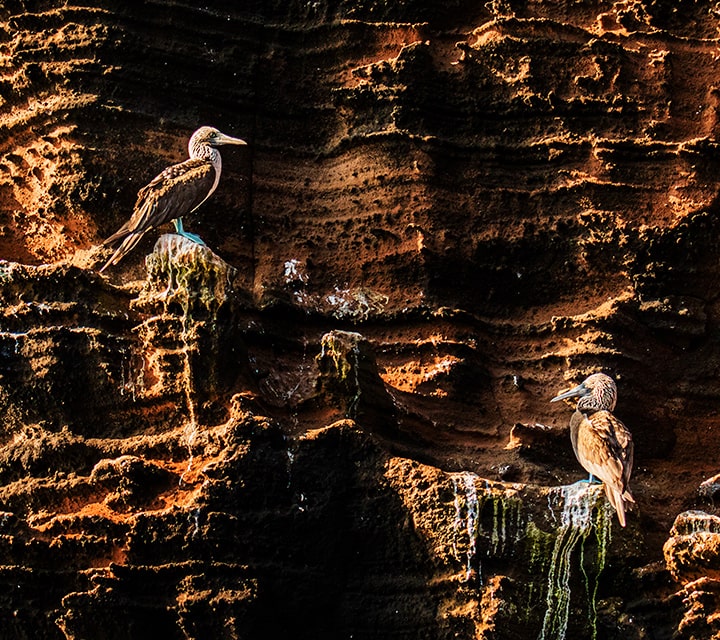
Facing Human-Induced Threats
Fishing nets also pose dangers. While diving for fish—their primary diet—boobies may get entangled in discarded fishing gear causing injuries or even death.
Tourism presents another issue, with potential disturbance during breeding seasons leading to nesting failures among pairs of boobies trying desperately to lay eggs successfully while juggling the constant stream of human visitors fascinated by them.
Coping with Natural Challenges
Natural factors aren't kind either. Changes in ocean temperatures directly impact the availability of flying fish they feed upon, affecting mortality rates amongst juveniles—especially those who require plenty of nourishment to grow into healthy adults capable of performing enchanting mating rituals to woo partners and reproduce the next generation of feathered entertainers.
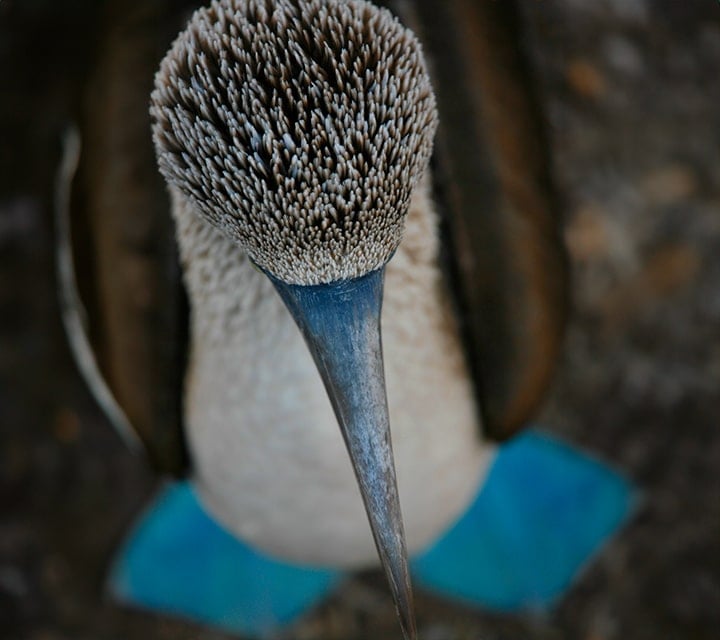
But let's not forget their vibrant blue feet. An indicator of health, these turquoise treasures can dull in color due to dietary changes or stress—a clear signal that all is not well in booby paradise.
Key Takeaway
The Galapagos blue-footed booby's survival is at risk due to both human and natural threats. Conservation groups work tirelessly to protect their habitats, yet issues like plastic pollution, discarded fishing gear, intrusive tourism, and climate-induced dietary changes persist. The vibrancy of the boobies' iconic blue feet serves as a poignant symbol of these ongoing challenges—an alluring cry for help that we cannot ignore.
The Intriguing Facts and Adaptations of Blue-Footed Boobies
Ever wondered about the strange name or vibrant feet coloration of Galapagos blue-footed booby? The Spanish word "bobo", meaning “stupid”, refers to their clumsy gait on land. But don't be fooled—these birds are expert fliers and divers.
Now let's talk about those remarkable turquoise feet. Their hue is not just for show; it plays a critical role in attracting potential mates. In fact, female boobies choose males with brighter foot coloration as this signifies better health.
This adaptation comes from carotenoid pigments found in their diet which mainly consists of fish like sardines and anchovies.
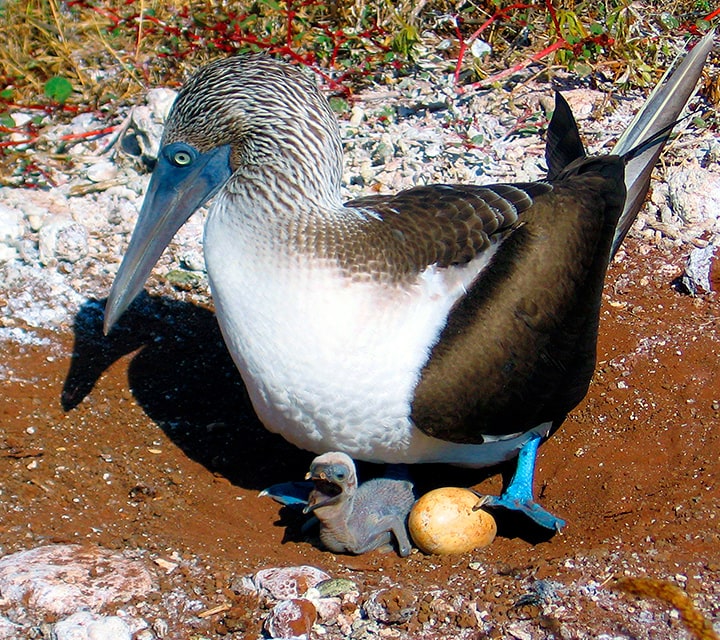
Nazca Booby: A Close Relative
If you thought only one species boasted colorful footwear, think again. Meet the Nazca Booby — another member from genus Sula who shares a habitat but sports yellow-orange toned shoes instead. Isn't nature fascinating?
Facts:
- The Sulidae family includes 10 different species, each having distinct adaptations aiding survival within diverse habitats ranging from the Galápagos Islands to coastal South America.
- Their long pointed wings allow for efficient flight over large water bodies in search of prey.
- Boobies lay eggs on bare ground without any nest material. This is an adaptation to their cliffside breeding habitats where building a conventional nest would be impossible.
In the wild, it's survival of the fittest, and blue-footed boobies certainly put their best foot forward.
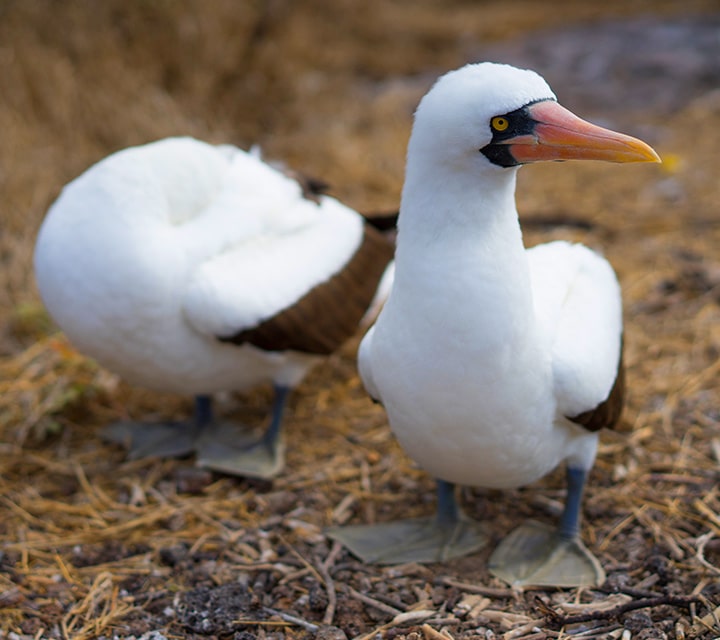
Key Takeaway
Although being named for the Spanish word for “stupid”, the booby is surprisingly graceful in the air and underwater. With their distinctive feet, keen vision, and skillful hunting tactics, these birds are true marvels of nature's design. And remember: a brighter foot color means a healthier bird—it all comes down to diet.
Exploring the Habitat of Blue-Footed Boobies in the Galapagos Islands
The Galapagos Islands, an incredible group of islands near South America's Pacific shoreline, harbor numerous extraordinary animals. One such inhabitant is the charming blue-footed booby, with its distinctive turquoise feet and long pointed wings.
Santa Cruz Island offers an abundant habitat for these blue-footed boobies. They seem to enjoy areas with bare ground where they can easily spot their prey from above. Their blue feet contrast sharply against this landscape making them easy to identify.
The environment plays a significant role in shaping booby populations on each island within this diverse archipelago. With 13 endemic species of sea birds residing here, it's truly an ornithologist’s paradise.
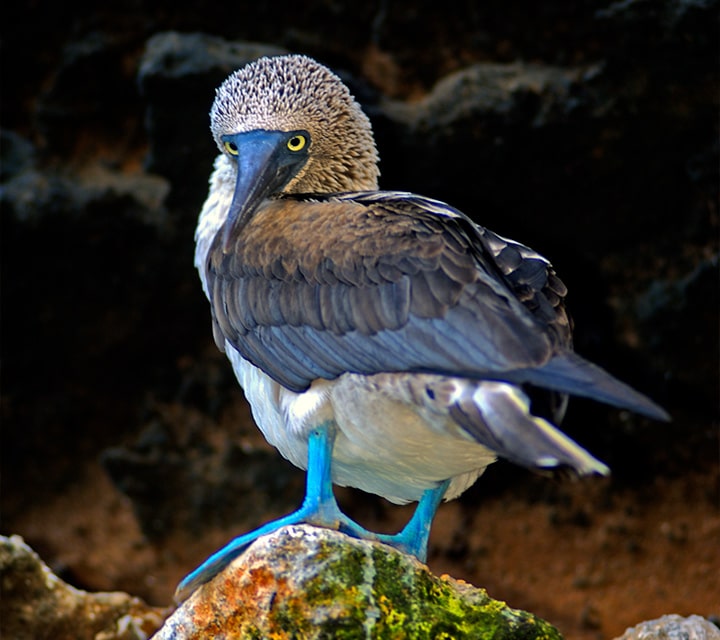
Habitat Influences Behavior
The influence of habitat on boobies’ behavior is quite intriguing. For instance, their diet predominantly consists of flying fish, which influences their feeding habits as well as the coloration of those striking blue feet.
This choice of food isn't arbitrary though; there's logic behind it. The waters surrounding these islands are teeming with flying fish, providing an ample source for nourishment and indirectly contributing towards soil enrichment through droppings.
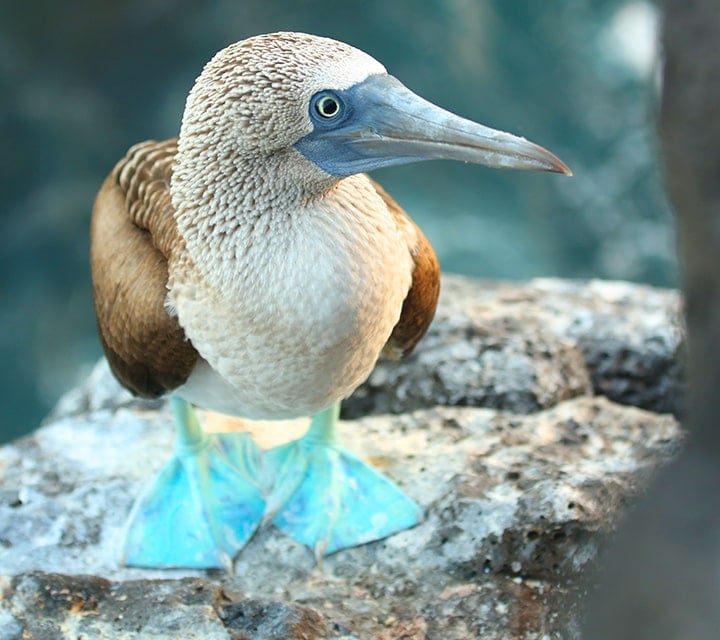
Why Choose Such Remote Habitats?
You might ask why these vibrant birds choose remote habitats like the Galapagos. Well, despite appearing 'bobo' (a Spanish word meaning “stupid”), they're anything but that. These locations offer less competition and more resources, leading to lower mortality rates among chicks. Clever right?
A Paradise Threatened?
Unfortunately, even this isolated haven faces threats from climate change affecting breeding problems among blue-footed boobies. Despite these challenges, their numbers remain relatively stable thanks to ongoing conservation efforts.
Visiting the Islands during a Galapagos luxury cruise and observing blue-footed boobies in their natural habitat is an experience of a lifetime. The enchanting dance moves performed by male booby during mating rituals will surely be a highlight.
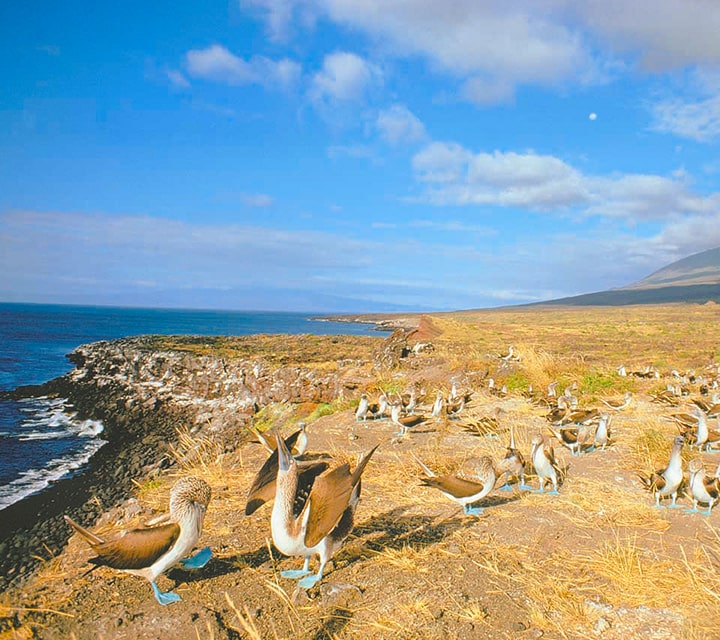
Key Takeaway
The Galapagos Islands are a haven for unique wildlife, including the charming blue-footed booby. Their habitat on Santa Cruz Island provides an ample food source and low competition, influencing their behavior and survival. However, climate change poses threats to these vibrant birds despite ongoing conservation efforts.
Conclusion
And there you have it—a fascinating journey into the world of the Galapagos blue-footed booby.
We've seen their distinctive blue feet, caused by carotenoid pigments in their diet. You've learned about their peculiar mating dance and behavior patterns affected by population dynamics.
We delved into how these birds lay eggs on bare ground and the breeding problems they face due to mortality rates. It's been enlightening to understand their feeding habits which center primarily on flying fish, and learning about conservation efforts made for this unique species.
The takeaways are clear; each aspect of nature holds surprises like these vivid-footed boobies with interesting behaviors. Let's keep discovering more to be able to better support the preservation of this invaluable biological diversity. Let's continue our exploration! To learn even more & go into more depth: Galapagos Blue-footed Boobies
